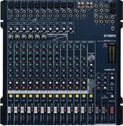Yamaha MG166CX-USB 16-Channel Mixer Jazztimes Review
|
Yamaha MG166CX-USB 16-Channel Mixer |
||
 Because many house PA systems are less than stellar, gigging musicians often find themselves responsible for providing sound reinforcement at their gigs. But who really wants to heave all that heavy hardware around? Yamaha's MG166CX-USB mixing console
provides an answer to this problem by folding effects, compression and digital recording into a lightweight package.
Because many house PA systems are less than stellar, gigging musicians often find themselves responsible for providing sound reinforcement at their gigs. But who really wants to heave all that heavy hardware around? Yamaha's MG166CX-USB mixing console
provides an answer to this problem by folding effects, compression and digital recording into a lightweight package.
In fact, the first thing you will notice about the mixer is its weight, a trifling 12 pounds! It's easy to manage with one arm by itself, but can be installed in a rack. All of its controls and inputs, with the exception of power and the USB port, are accessible from the front of the mixer, a big plus when plugging in cables. The power input is not the standard IEC power cable that comes with most professional-level electronics equipment but rather a proprietary plug attached to a large power block. Using a power block reduces the weight of the mixer, but Yamaha failed in the plug aspect of the design: If you break this singular power cable on a gig, you're outta luck and will not easily find a replacement. The layout of the mixer is standard; however, like most Yamaha boards, the amount of tiny text makes it appear cramped. The number of inputs is impressive for a board of this size: 10 mic (XLR), 10 line (TRS), two stereo line inputs (TRS and RCA) and a two-track RCA input with its own level control knob (good for playing music off of a portable CD player between sets). Since those RCA line inputs on channels 13/14 and 15/16 are formatted as a channel strip, they have EQ, aux sends and effects capabilities, a rare treat not found on most boards. Inserts are available on the first eight channels and there are three aux sends, but you'll be hard-pressed to use them with six channels of onboard compression and effects on every channel. The compression is easy to use and will help you tame a wild guitar or vocal in seconds. It's available on the first six channels, which is more than enough for the typical band. Unlike most compressors, which typically have four or more parameters to adjust, Yamaha has simplified the process with just one knob. But beware-like most compressors, this one sounds best when used sparingly. |
The onboard effects on the MG166CX-USB are perfectly suited for sound reinforcement. Various hall, room and stage reverbs are
included, plus two kinds of echo, chorus and four "special effects": distortion, wah-wah, phaser and flanger. You can change the
parameters of the various effects with the turn of a knob. Does the hall reverb make your saxophone sound like you're blowing from
the bottom of a well? Turn the parameter knob counter-clockwise to shorten the length of the reverb to taste. You can also use a
foot pedal (not included) to turn the effects on and off remotely. These effects are easy to use, and they sound good enough that
you can leave that reverb box at home.
For the money, the EQ on the MG166CX-USB sounds great, better than other boards in its class. The EQ is clean and transparent and is available on all 16 channels. The high and low EQs are fixed at 10kHz and 100Hz respectively, but the mid EQ on the first eight channels is "sweepable," meaning it's controlled by two knobs: one that lets you pick the frequency (anywhere from 250Hz to 5kHz) and a second that lets you adjust its level (perfect for handling a honky horn or a bright bass). The MG166CX-USB has one final trick up its sleeve: the ability to record a stereo mix via USB to a computer. Cubase AI4 (compatible with Mac OSX and Windows XP and Vista) is supplied with the mixer, but unlike the MG166CX-USB, Cubase AI4 is not plug-and-play, and some setup is required, along with a bit of a learning curve. Ultimately, most gigging musicians will find it too cumbersome (and too risky) to lug along a laptop and its associated gear on top of everything else just to record a simple stereo mix of their performance. It is more likely that one would use a handheld stereo flash recorder like the M-Audio MicroTrack II or the Edirol R-09 in combination with the "Rec Out" RCA connections. If this is the case, one of the less expensive mixers without USB in Yamaha's MG line should be considered. However, anyone looking for a simple introduction to home recording may find that the USB capability of the MG166CX-USB meets his or her needs. The Yamaha MG166CX-USB is a strong contender in the small-format mixer market. With an online price tag of $500, a lightweight design, and the addition of easy-to-use onboard compression and effects, any musician looking to build a small venue-ready system should seriously consider Yamaha's MG line. ROB BYERS |
|
